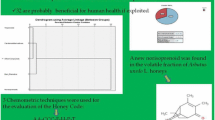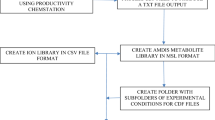Abstract
In an effort to investigate whether Hellenic honey is favorable to contamination, a metabolomic approach using gas chromatography coupled to mass spectrometry (GC/MS) in combination with headspace solid phase microextraction (HS-SPME) was applied for the analysis of 203 monofloral honey samples of different botanical origin (citrus, fir, pine, and thyme). For semi-quantification purposes, the use of the internal standard method was considered. Results showed that some honey samples had an exogenous volatile profile consisted of four volatile metabolites: dichloromethane, chloroform, cyclohexane and toluene, which are probably contaminants. These volatile compounds were semi-quantified in diverse amounts, and classified in relation to honey botanical origin with the use of chemometrics. Toluene proved to be the major contaminant in, however, a diverse range (0.001–0.163 mg kg−1) and frequency of occurrence. Apart from chloroform in which, a zero tolerance maximum residue limit has been proposed in the EU legislation, the study sets the questioning in both national and international authorities to establish the upper limit for some other exogenous volatile compounds identified in honey.



Similar content being viewed by others
References
Castro-Vázquez L, Díaz-Maroto MC, González-Viñas MA, Perez-Coello MS (2007) Aroma composition and new chemical markers of Spanish citrus honeys. Food Chem 103:601–606
Kadar M, Juan-Borrás M, Carot MJ, Domenech E, Escriche I (2011) Volatile fraction composition and physicochemical parameters as tools for the differentiation of lemon blossom honey and orange blossom honey. J Sci Food Agric 91:2768–2776
Nayik GA, Nanda V (2015) Characterization of the volatile profile of unifloral honey from Kashmir valley of India by using solid-phase microextraction and gas chromatography-mass spectrometry. Eur Food Res Technol 240:1091–1100
Nayik GA, Nanda V (2015) Physico-chemical, enzymatic, mineral and colour characterization of three different varieties of honeys from Kashmir Valley of India with a multivariate approach. Polish J Food Nutr Sci 65(2):101–108
Nayik GA, Nanda V (2016) A chemometric approach to evaluate the phenolic compounds, antioxidant activity and mineral content of different unifloral honey types from Kashmir, India. LWT-Food Sci Technol 74:504–513
Karabagias I. (2021) In search of honey authentication. Cambridge scholars publishing. ISBN: 1-5275-6712-5; ISBN13: 978-1–5275-6712-2
Montenegro G, Gómez M, Casaubon G, Belancic A, Mujica AM, Peña RC (2009) Analysis of volatile compounds in three unifloral native chilean honeys. Int J Exp Bot 78:61–65
Council directive 2002/99/EC of 16 December 2002 laying down the animal health rules governing the production, processing, distribution and introduction of products of animal origin for human consumption. Off J Eur Commun L. 18/11–20 (2003)
Regulation (EC) No 470/2009 of the European parliament and of the council of 6 May 2009 laying down community procedures for the establishment of residue limits of pharmacologically active substances in foodstuffs of animal origin, repealing council regulation (EEC) No 2377/90 and amending directive 2001/82/EC of the european Parliament and of the council and regulation (EC) No 726/2004 of the European parliament and of the council, L. 152/11–22 (2009)
Council regulation (EEC) No 2377/90 of 26 June 1990 laying down a community procedure for the establishment of maximum residue limits of veterinary medicinal products in foodstuffs of animal origin, L. 224/1–112 (2003)
EU legislation: Honey intended for human consumption, CBI ministry of foreign affairs of the Netherlands, 2011
Louppis AP, Karabagias IK, Kontakos S, Kontominas MG, Papastephanou C (2017) Botanical discrimination of Greek unifloral honeys based on mineral content in combination with physicochemical parameter analysis, using a validated chemometric approach. Microchem J 135:180–189
Karabagias IK, Nikolaou C, Karabagias VK (2019) Volatile fingerprints of common and rare honeys produced in Greece: In search of PHVMs with implementation of the Honey Code. Eur Food Res Technol 245(1):23–39
Alltech associates Inc., Chicago, IL, USA (1998)
Piasenzotto L, Gracco L, Conte L (2003) SPME applied to honey quality control. J Sci Food Agric 83:1037–1044
Manyi-Loh CE, Ndip RN, Clarke AM (2011) Volatile compounds in honey: a review on their involvement in aroma, botanical origin determination and potential biomedical activities. Int J Mol Sci 12:9514–9532
Karabagias IK, Badeka AV, Kontakos S, Karabournioti S, Kontominas MG (2014) Botanical discrimination of Greek unifloral honeys with physico-chemical and chemometric analyses. Food Chem 165:181–190
Alissandrakis E, Kibaris AC, Tarantilis PA, Harizanis PC, Polissiou M (2005) Flavour compounds of Greek cotton honey. J Sci Food Agric 85:1444–1452
De la Fuente E, Martinez-Castro I, Sanz J (2005) Characterization of Spanish unifloral honeys by solid phase microextraction and gas chromatography-mass spectrometry. J Sep Sci 28:1093–1100
Mannas D, Altuğ T (2007) SPME/GC/MS and sensory flavour profile analysis for estimation of authenticity of thyme honey. Int J Food Sci Tech 42:133–138
Tananaki Ch, Thrasyvoulou A, Giraudel JL, Montury M (2007) Determination of volatile characteristics of Greek and Turkish pine honey samples and their classification by using kohonen self organising maps. Food Chem 101:1687–1693
1,2,3-Tribromopropane degradation pathway, Danijela Markovic, UMBBD (2011-08-15). Retrieved on 2011-11-28
Pontes M, Marques JC, Câmara JS (2007) Screening of volatile composition from Portuguese multifloral honeys using headspace solid-phase microextraction-gas chromatography-quadrapole mass spectrometry. Talanta 74:91–103
Human metabolome database (HMDB) (2019). http://www.hmdb.ca. Accessed 30 Apr 2019
Acknowledgements
The local beekeepers from the regions of Messinia, Symi, Lakonia, Samos, and Arta along with ATTIKI Bee Culturing Co.-ALEX. PITTAS S.A., are greatly acknowledged for the donation of honey samples. Assoc. Prof. Dr. Anastasia V. Badeka is also acknowledged for the access she provided to the Laboratory of Food Chemistry at the Chemistry Department of University of Ioannina for the use of the GC/MS unit.
Funding
This research did not receive any specific grant from funding agencies in the public, commercial, or not-for-profit sectors.
Author information
Authors and Affiliations
Corresponding author
Ethics declarations
Conflict of interest
The author declares that he has no conflict of interest.
Ethical approval
The study does not involve research on human participants and/or animals.
Informed consent
Not applicable.
Additional information
Publisher's Note
Springer Nature remains neutral with regard to jurisdictional claims in published maps and institutional affiliations.
Supplementary Information
Below is the link to the electronic supplementary material.
Rights and permissions
About this article
Cite this article
Karabagias, I.K. HS-SPME/GC-MS metabolomic analysis for the identification of exogenous volatile metabolites of monofloral honey and quality control suggestions. Eur Food Res Technol 248, 1815–1821 (2022). https://doi.org/10.1007/s00217-022-04007-w
Received:
Revised:
Accepted:
Published:
Issue Date:
DOI: https://doi.org/10.1007/s00217-022-04007-w




